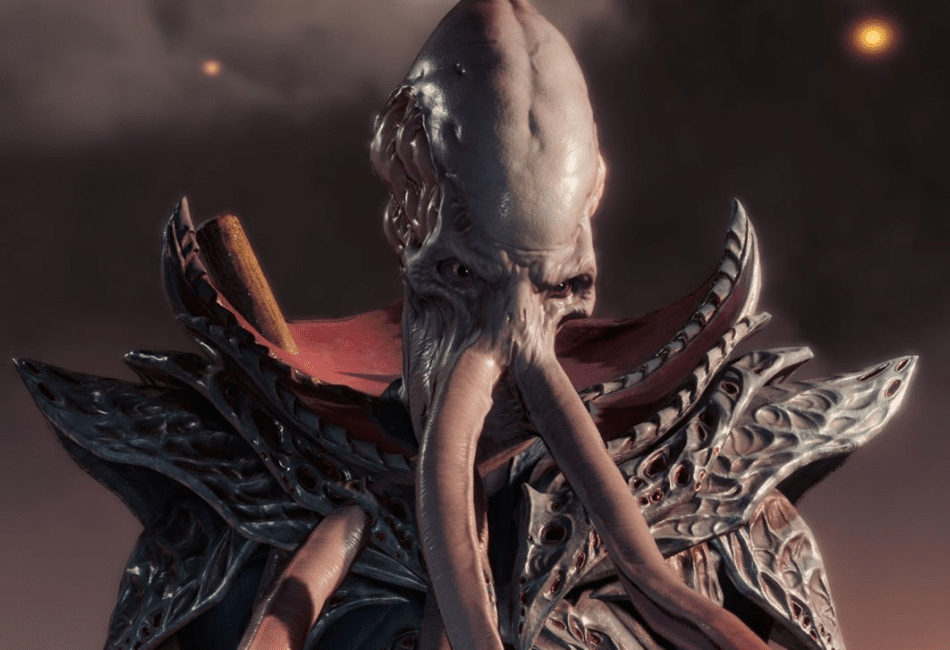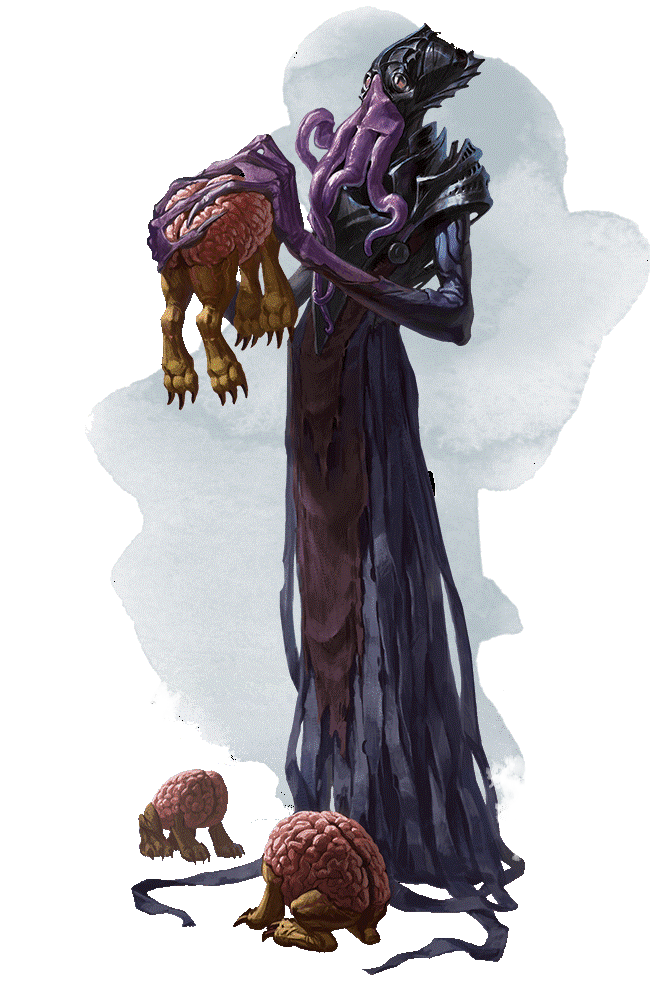The Underdark is known for many horrendous and twisted creatures in DnD. However, few are more pompous and demanding of their environment than the Illithid, The Mind Flayer.
A single Illithid and its countless minions should test every tactic your party has coveted and, hopefully, force them to discover new ones. An entire colony of them should make them wonder if they have somehow wronged the person DMing their campaign.
The Illithid purposefully shroud themselves in mystery, much like the Lovecraftian tales they were inspired by; the Mindflayer knows most of its horror lies in the secrets they keep.
So, as your guide through this portion of the Underdark, let me pull back some of their secrets and hopefully avoid having my brain nommed on by a fallen empire of squid faces. Let’s begin our Mind Flayer 5e Guide by summarizing Illithid.
Illithid Summarized
Books: Monster Manual (Monster Stats), Volvo’s Guide to Monsters (Society, details, hive structure)
- Illithid is their UnderCommon name.
- An Illithid’s main move is to attempt to ‘dominate monster‘ on who they assume is the most vital party member.
- A Mind Flayer can not extract a target’s brain that they are not actively grappling with.
- Extract Brain can not be done on the same turn as the grapple. This gives the player and party a single turn to prevent this.
- While using Extract Brain, the Illithid is vulnerable. They will take this into consideration in their plans.
- A Mind Flayer will try to flee if they are in a situation they do not believe they can win.
- Unless you are fighting an Illithid that has gone rogue against their Hive mind, the chances that there are more nearby are very high. Regardless, thanks to the initial Mind flayer, they all know you are there.
Mind Flayer Statblock
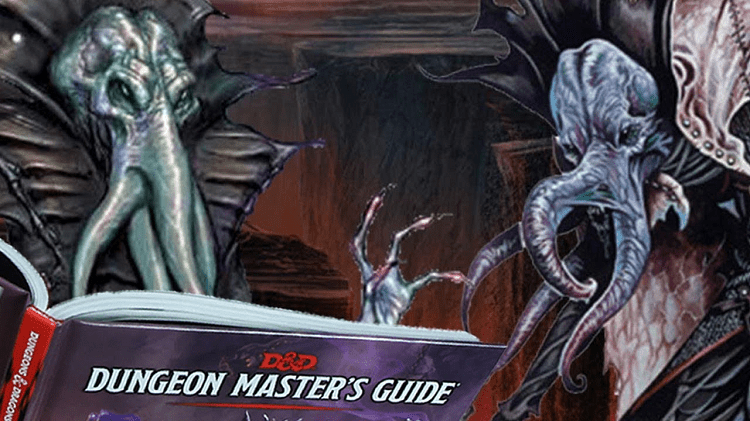
Medium Aberration, Lawful evil
- AC: 15
- HP: 71 (13d6+13)
- Spd: 30ft
- Str: 11 (0)
- Dex: 12 (1)
- Con: 12(1)
- Int: 19 (4)
- Wis: 17 (3)
- Cha: 17 (3)
- Saving Throws: Int +7, Wis +6, Cha +6
- Skills: Arcana +7, Deception +6, Insight +6, Perception +6, Persuasion +6, Stealth +4
- Senses: Darkvision 120 ft., passive Perception 16
- Languages: Deep Speech, Undercommon, telepath 120 ft
- Challenge: 7 (2900 XP)
- Magic Resistance: advantage on saving throws against spells and magic.
- Innate Spellcasting: The Mindflayer can cast the following without any components and regents.
- At-Will: detect thoughts, levitate
- 1/day each: dominate monster, plane shift (self only)
Actions
Tentacles: Melee Weapon Attack: +7 to hit, reach 5 ft, one creature.
- Hit: 15 (2d10+4) psychic dmg. Medium/Small targets are grabbed (escape DC 15). Upon grappling, the target needs to succeed in an intelligence DC 15 or be stunned.
Extract Brain: Melee Weapon Attack: +7 to hit, reach 5 ft., one incapacitated humanoid grappled by the Illithid.
- Hit – 55 (10d10) piercing damage. If the target’s HP is reduced to zero, the Illithid kills the target by extracting and devouring their brain.
Mind Blast (Recharge 5-6) The mind flayer magically emits psychic energy in a 60-foot cone. All affected creatures must make a DC 15 saving throw or take 22 (4d8+4) psychic damage or be stunned for one minute (10 rounds). At the end of each target’s turn, they may repeat the saving throw to end this effect early.
Illithid Society
In the far distant future, a terrible fate has befallen reality. Resources have dwindled, and a chaotic unknown entity has caused the Illithid empire to flee through time.
This is at least one of many theories of the Mindflayers’ origin. They appeared like pirates from the Far Realm onto the multiverse’s distant past.
Thousands of years ago, the first empire of the MindFlayers rapidly spread through the Inner Planes. For millennia they were the dominant force in the galaxy. They even dominated the astral plane through the use of organic spacefaring vehicles.
At least, this is what some sages say of their beginnings. But, in truth, the origins of the ruined Illithid kingdom are shrouded in mystery.
Not even the Aboleth that have lingered since before the material have a clue as to where the spacefaring, Underdark lurking squid-headed civilization originated. So, I am saying that Illithid history is purposefully vague yet complex.
It is agreed, however, that this prosperous time in Illithid history was halted by hubris. The Illithids had long made use of many species for slave labor.
The most prominent was a race known as the Giphthh and would go on to be spelled as Gith, thanks to a Giphthh named Mr. Gith. Mr. Gith and several other Giphthh started a rebellion that lasted only a year and shattered the Mindflayer Empire.
The Gith split into the Githyanki and Githzerai while thinning the Mind Flayers until the Illithid kingdom was reduced to mere outposts scattered across Clusterspace, the Astral Planes, and most prominently, the Underdark.
Hive Colonies
While some solitary Mind Flayers are about, the large bulk of these individuals are likely outcasts, rogues, or rebels of their own kind. The rest have split into colonies.
Unfortunately, these colonies are usually hidden deep underground and were carved out long before sapient minds could witness their creation.
This allows many colonies to harvest brains and adventurers without the surrounding kingdom questioning it as anything more than the drow.
These colonies are structured around a single Elder Brain per colony which they consider their first priority. After this crucial function, the settlements also act as storage for food, laboratories for their various alien studies, and places to plan the next food run.
As Mind Flayers can levitate at will, they have built their hives with their paranoia in mind. As a result, their colonies are full of shoots that they can traverse easily. Yet are difficult for landlocked creatures or winged fliers to follow through.
Elder Brain
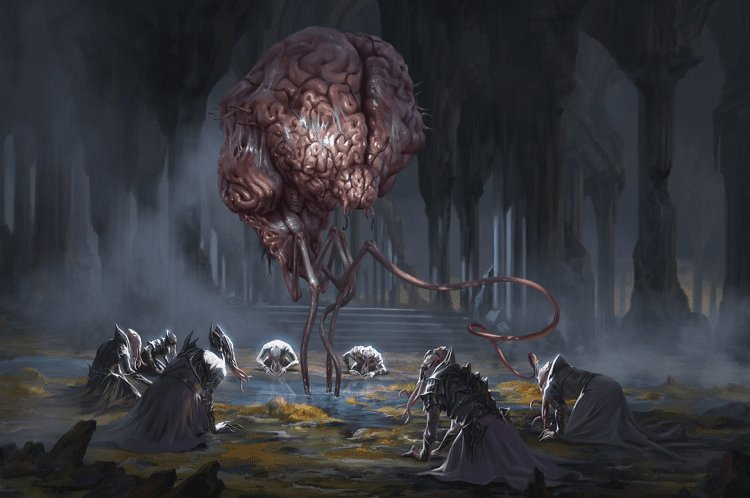
Unless a rebel Illithid or an Ulitharid is on the path to settling a new colony, all Mind Flayers are a part of a hive mind. These hive minds are individual to their settlement and all sourced to one Elder brain at that colony’s center.
Illithids will do everything to keep their Elder Brain safe. This is to the point few adventurers even knew of its existence, much less its importance to the colony. It appears as a massive brain with tentacles growing from it, living in a brine-filled pool.
The brain matter was developed from the brains of long-dead mind flayers and particularly intelligent captives. As a Mind Flayer grew old or feeble, it would prepare to have its brain given to the Elder Brain forever live on as a piece of the greater hive-mind.
Thanks to this, its mind-affecting powers were unmatched.
Unlike a Mindflayer, an Elder Brain alone is a CR 14. However, they are rarely alone and usually have the entire colony of Illithids rushing for the chamber the moment you prove to be a threat.
It can attack and grapple with its tentacles. Worse, in the same turn, it can use psionic attacks with the power of an entire hive mind and even cast spells as powerful as a sorcerer.
An Elder Brain encounter should never be taken lightly. It should concern even the deities, as they would remember the time these brains spanned the multiverse.
Qualith
Thanks to their vast intellect, an Illithid rarely needs to keep something written down. However, if they decide to do so, they do so in the tactile writing system Qualith. Similar to braille, the language is read through the use of their tentacles.
Qualith is written in four-line stanzas. This could be so they can read each line with a tentacle, reading all four lines in a stanza at once. However, it is considered so alien compared to the average humanoid language that non-Illithids must resort to magic means to decipher what it says.
Illithid Reproduction
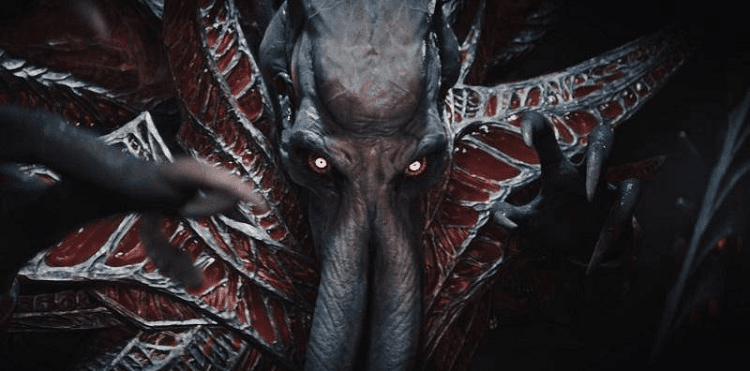
A Mindflayer does not reproduce sexually. Instead, the Hive will birth numerous tadpoles, which have to survive the brine pools of the Elder Brain. Upon maturity, it will be inserted into paralyzed or stunned creatures.
These ‘illithid tadpoles’ are inserted through the eye, where they will burrow into the brain. From there, it will eat away at its brain, both eating away at the victim while allowing itself the nutrients to grow and start the process of change known as Ceremorphosis.
Complex-minded victims were generally required. Humans, Elf & Drow, Gith, Orcs, and Goblinoids would most commonly birth an Illithid with an Ulitharid rarely birthed from the process.
Other creatures could be birthed from the process; however, these are known as Ceremorphs and are often considered to be only ‘half-Illithid’ by their brethren.
Ulitharid
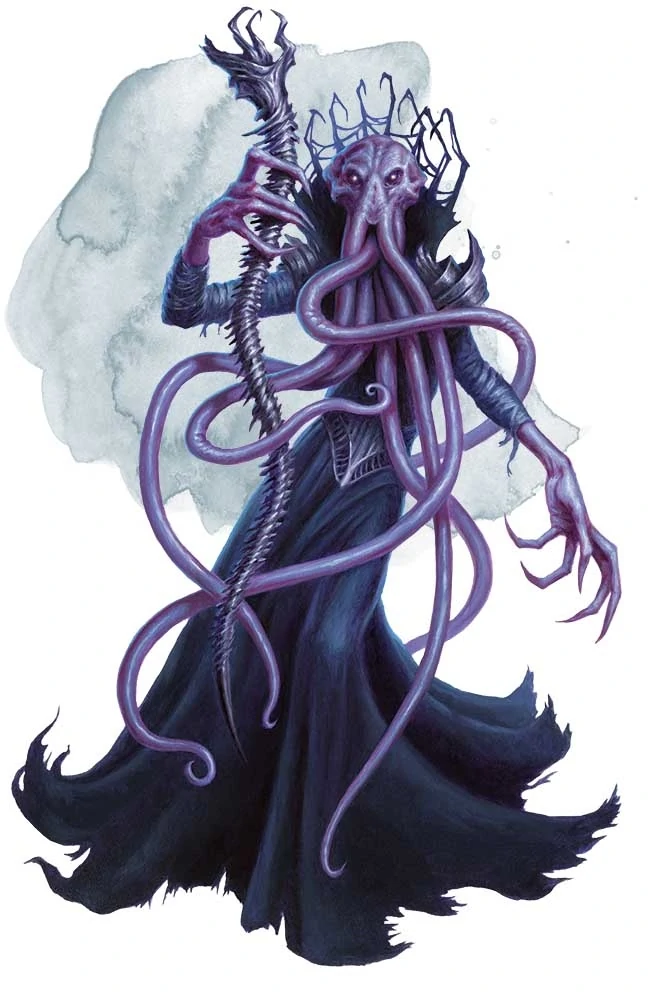
Stronger than the Illithid and fretfully smarter, rarely does a Ulitharid grace the ceremorphisis process. They are, as such, treated by their brethren as minor gods directly under their central Elder Brain.
A tadpole that will birth a Ulitharid is not noticeably different until the Ulitharid is born. It is unknown what causes this change, but it happens somewhere between 1 in 25 million to 1 in 100 million Illithid tadpoles.
The most significant difference these variants showed was a spiteful yet helpful presence in their colonies. The Ulitharid would typically improve and empower their settlement while struggling in power with their host brain. This is merely a part of the cycle and the reason for their rarity.
It is in the nature of an Ulitharid to vie for power until they inevitably split from their colony. First, they will take as many as half the settlement’s inhabitants and splinter off. Then, the Ulitharid will seek to secure a food source with its colony.
Once this is complete, the Ulitharid will evolve into the Elder Brain of this new, prosperous Hive colony, allowing more Illithid to be birthed. Someday, another Ulitharid will eventually be birthed to settle the land anew.
Every miracle has a reflective nightmare. This includes the miracle of birth.
Ceremorphs
There are various Ceremorphs with far more to be discovered. While they usually possessed most, if not all, of the traits of an Illithid, they were still considered unique to their own degree.
Thanks to the individual abilities they would grant the colony, these creatures were generally always made to serve a specific function in their territories. Regardless of their power, all but the most powerful Ceremorphs could function outside the will of their Hive’s Elder Brain.
For example, a Dragon that undergoes Ceremorphosis will result in a Brainstealer Dragon. As you would imagine, these look like dragons if they had been melted a little while and given horrible squid-like faces.
These creatures could sometimes be found at the center of a hive in place of an Elder Brain.
On the other hand, a Beholder that undergoes the process will create a Mindwitness. They look like a beholder with a glassy eye and tentacles squirming from their bottom half. These creatures were customarily made to function as telekinetic upgrades to a hive colony’s psionic network.
Illithid Tactics
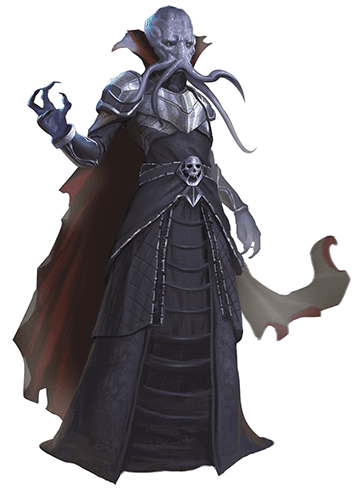
Should the Illithid still have its 1/day ability to ‘dominate monster,’ it will seek out to find who it believes is the strongest or most vital member of the party and turn them before any other tactic.
The Illithid will often seek to weaken the party using its Thralls. However, thanks to its ability to speak with these creatures telepathically, it will usually do so while staying hidden on the field until its moment to strike.
If all else fails, if they haven’t used this option that day, the Mind Flayer will plane-shift themselves off the field entirely.
Suppose the creature is too powerful for the Illithid to dominate but would still make a good thrall.
In that case, the Mind Flayer may play to pull the beast away to gain the assistance of the entire colony to convert them. Such as with a Dragon or Beholder to make a Brainstealing Dragon or Mindwitness, respectively.
Grappling & Stunning
If an enemy looks like they are on the ropes, the Mind Flayer will prioritize them to grapple and consume their brains.
Otherwise, they will favor Mind Blast and seek to stun as many party members as possible. In addition, they will often try to herd them into the shape of their cone of effect using their thralls and the landscape.
The Mind Flayer rules require them to grapple a play, stunned or not, on one turn and extract the brain on the next turn. Thanks to how vulnerable ‘Extract Brain’ leaves the Illithid while in use, they will only do so if they feel safe.
Psionics
Mind Flayers are masters of psionics and are further granted knowledge and strength from their Hive. While leaving the physical combat to their Thralls, a mind flayer would prefer to stay hidden, command the battlefield through psionics, and mind blast the party whenever the angle presents itself.
Thralls
Through the use of psionics or massive multi-mind flayer rituals, a Mindflayer will generally always be found with an army of minions that they have forced under their whims.
Illithids will control their Thralls through telepathy, often before the party knows they are there. They will fight and, from the machinations of some particularly powerful and unsettling Illithid, puppet slivers of their memories to appear like free-willed individuals.
This is merely an act. The mind and memories of the victim have long since been consumed by the Hive.
Enslaved Thralls give the mind flayer, through the Thrall, any of the tactics or abilities of the enslaved creature.
Intellect Devourers
Resembling brains growing a pair of limbs. Sometimes, the brains the mind flayer collects are used as a thrall. While physically weak, the danger of an Intellect Devourer is their intent on fixing that problem.
An intellect devourer will immediately seek a host under the direction of their Mind Flayer. They will then consume a creature’s mind and memories while taking it over as a thrall. Some truly wicked Illithid have been said to hide intellect devourers in the bodies of other Thralls.
How to Fight Illithid
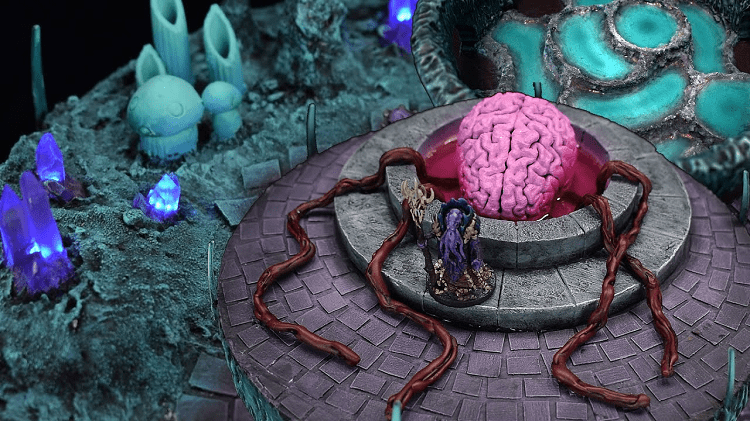
A Mind Flayer’s physical traits are notoriously weak for all the terror they can cause with their psionic might and tentacles.
Typically, an Illithid will know the party dynamic better than the party does through paranoid sleuthing. As such, taking advantage of them should be considerably difficult. A well-thought-out plan and adjusting your strategy the moment a mind flayer catches on is a good strategy.
The other is to make sure to never align yourself into a cone. A mind flayer will try to play this like tic-tac-toe and make you out-think yourself.
Flanking both sides of the Illithid will work until they retreat. You should immediately move as flanking places the party in a perfect position for a cone attack should the mind flayer be quick enough.
Most of all, keep your party’s health high. A Mind Flayer will strike when it believes you are weak enough to overpower and consume your brain.
To explain this in numbers. Attacks or spells that require wisdom, intelligence, or charisma will generally be easily shrugged off. Meanwhile, physical leaning Con, Dex, and Str focusing attacks will more easily overcome the mind flayer’s resistance.
Being both far enough to align themselves without risking a mind blast while also using martial attacks, an archer is one of the Illithid’s worst enemies.
If the mind flayer escapes using plane shift and attacks the party the following day, this will be a chance to kill it as they will likely have to use their once-a-day plane shift to return.
How to DM/Play an Illithid
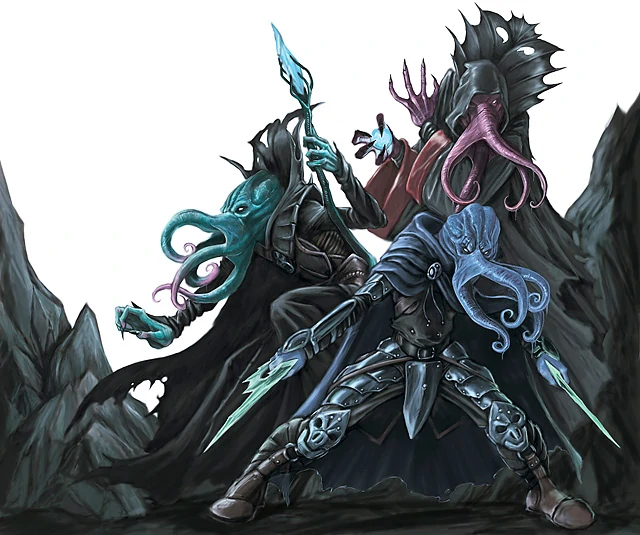
A Mind Flayer encounter should test how well the DM knows its players as much as it pushes the players themselves.
Thanks to their vast intelligence and tendency to scout and chatter amongst the hive mind, anything the DM has learned about their players up to this point should influence the Mind Flayer’s actions.
Do so to test and terrify your players, not outright murder them. But, of course, the Illithid does want to murder them, so don’t let up on them either.
Even the weakest of Illithids could strike overwhelming terror into a player. They hold the reputations usually reserved for Beholders and your personal BBEG of the campaign. Many of their attacks can overwhelm a party, and most of all, the Illithid is out to kill you.
It wants your brain, unlike a mindless zombie; however, the Illithid has been calculating and honing this hunting tactic since the beginning of time. If you listen to the whispers of time travel, before even then.
As such, they will constantly be out to outsmart your players and will adapt to anything that doesn’t outright kill them. To that end, they also know when to flee to regroup, often retreating further into their dungeon.
Some might consider them cowardly due to this. On the contrary, as members of a fallen kingdom, they are crafty and instead engineer the landscape. An Illithid will only fight without an escape plan if it is confident it will win or is in a dire situation.
Suppose you believe your players might win without feeling like a full-party wipe is around every corner. In that case, the Mind Flayer should seek to retreat until it can bend the battlefield to its advantage.
Often by using more powerful thralls to weaken the party. If not a renegade Illithid, they will innately know where other Hive members are and can retreat to an ambush that was informed of the situation through telepathy.
If a party member falls to an Illithid, they will have their brain sucked out and become a thrall. Foreshadow this potential and treat the party’s single turn to save that member as the tensest moment of their campaign.
Mindflayer FAQs
Question: Why do Mindflayers Eat Brains?
Answer: Thanks to being from the end of time and then further evolving through its beginning, Mindflayers hold incredibly advanced biology that requires specific nutrients to function and keep running.
This diet of hormones, enzymes, and psychic energy is conveniently all found in the brains of intelligent creatures. Illithids will also harvest and store these brains for scientific endeavors such as the creation of Intellect Devourers.
The issue is that a Mindflayer’s diet requires increasingly complex brains. In addition, their paranoia, thanks to the whole Gith Rebellion phase of their empire, leaves them constantly battling between hiding from extinction and potentially revealing their hunting territory by venturing into it.
Question: What Type of Thralls should My Illithid be Using?
Answer: The typical answer and the example I gave in the guide above list weaker Underdark creatures such as Grimlocks and Quaggoths.
However, the minions a Mind Flayer collects will be based on where it is stationed. A Hive Colony or Rogue Illithid that has placed itself in the Fae Wylds for some crazy reason, for example, will have made use of creatures like the Redcaps in the Underfey.
If it conceivably came across the Illithid and was weak enough to fail on a dominant monster from the Illithid, welcome to the Hive. If it is more powerful than the Illithid but not powerful enough to take on many Illithid, welcome to the Hive.
Question: What is the Strangest Mind Flayer Fact You Encountered Researching this Guide?
Answer: There once was a great Archwizard known as Loulaum. After the fall of his kingdom, he conspired with a cabal of Illithiliches, also known as Alhoons, so he could be formed into an Undead Elder Brain.
This ritual then merged Loulaum’s consciousness into this abomination, which would go on to be known as the Oracle of Ellyn’taal.
As, during this time, the man was ALREADY a Lich, I could not figure out why in the blazing blue skulls he would want to do this. Minus the fact the idea is, admittedly, metal.
Conclusion
Thanks to their inherent paranoia, an accurate scale of the Illithid empire these days is unknown even among their own kind. An outpost could be lurking just below any city, in any plane of reality.
Their empire might have fallen, and the Gith that rose from their ashes might be doing its best to thin the herd. Still, if the Illithid have anything to say about it, it will only be a matter of decades before their empire span the planes like it had in the past.
While there are plenty of ways to spice a campaign with hints and hauntings of mind flayers, proper handling of a Mind Flayer infestation is a campaign-worthy adventure in and of itself.
However, suppose you find yourself as a DM with several plot threads that just needs one slightly squirmy skeleton to give it foundation. In that case, I can not suggest experimenting with the horrors of the Illithid yourself.
You never know when that thing you thought was a zombie will turn out to have a walking brain looking for your skills as an adventurer!
- Blight 5e Guide: Blood-Thirsty Brambles - August 28, 2022
- Constructs 5e Guide: Intimidating Innovation - August 20, 2022
- Modrons 5e Guide - August 13, 2022

